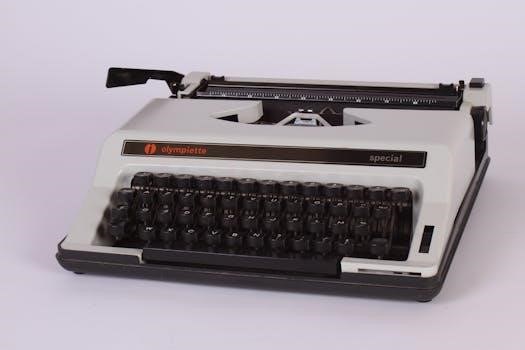Clicker keypads offer convenient wireless access․ These manuals provide essential instructions for programming and operating your device․ They often cover keyless entry and garage door opener functions․ Understanding the manual is crucial for proper use and maintenance․
Understanding Clicker Keypad Functionality
Clicker keypads utilize radio frequency to transmit signals, enabling wireless control of devices like garage doors․ These keypads operate by sending a coded signal when a button is pressed, which is then received by a compatible receiver․ The core function revolves around converting button presses into specific commands, facilitating actions like opening doors․ Many keypads incorporate a personal four-digit code system․ This adds an extra layer of security, preventing unauthorized access․ Keypads usually have an automatic and manual tick function, for signal sending․ The automatic tick function continuously transmits signals․ The manual tick function only sends signals when a button is pressed․ The clicker keypad interacts with other devices wirelessly, offering a convenient way to manage access․ The clicker can use different frequencies and protocols, depending on the manufacturer and model․ Understanding these aspects enhances the overall user experience․

Programming Your Clicker Keypad
Programming a clicker keypad involves setting up its communication with target devices․ This usually requires following specific steps provided in the manual․ Different brands may have unique programming methods․
Initial Programming Steps
Before using your clicker keypad, initial programming is essential․ This process usually involves clearing any previous settings, returning the device to its factory default state․ Consult the manual to identify the appropriate reset procedure․ Often, this requires pressing a sequence of buttons on the keypad․ Once reset, you’ll need to prepare your target device, like a garage door opener, for pairing․ The manual will provide specific instructions on how to put the receiving device into learning mode․ Following this, you’ll need to input a designated code on the clicker keypad, which establishes the connection; This may involve pressing and holding specific buttons until confirmation is received, usually indicated by a light or sound․ Completing these steps ensures the clicker keypad is ready for use with your intended device․
Programming for Different Brands
Clicker keypads are often designed to work with various brands of garage door openers and other devices․ Programming for different brands involves selecting the appropriate mode or setting on your keypad․ The user manual will provide a list of compatible brands and the corresponding programming codes or steps․ This might involve pressing specific buttons on the keypad in conjunction with the programming button on your target device․ Each brand may have a unique frequency or protocol, so it’s critical to consult your manual to ensure proper synchronization․ You may need to try different codes if the initial attempt is unsuccessful․ Some keypads feature an auto-learn option that automatically detects the brand, streamlining this process․ Correct brand programming ensures seamless communication and proper functionality with your opener or device․

Keypad Operation
Keypad operation includes entering personal four-digit codes for access․ It also involves understanding manual and automatic tick functions․ Proper use ensures secure and reliable entry through the system․
Using Personal Four-Digit Codes
The clicker keypad utilizes personal four-digit codes to grant access, enhancing security․ Each user can program a unique four-digit code, which is entered on the keypad to activate the door or gate mechanism․ These codes provide a convenient alternative to physical keys․ The backlit keypad ensures visibility even in low light conditions․ It is essential to select a code that is easy for you to remember but difficult for others to guess․ Refer to your specific manual for instructions on setting up, changing, or deleting personal four-digit codes․ Be sure to keep your code secure and avoid sharing it with unauthorized individuals․ This feature is a central component for keyless entry, allowing for a streamlined and safe access solution․ The use of personal codes makes it easy to manage access for multiple users․ Always follow the programming instructions precisely to avoid accidental lockouts․
Manual and Automatic Tick Function
The clicker keypad incorporates a “tick” function, which can operate in either manual or automatic mode․ In manual mode, the tick function requires a user to initiate it, often by pressing a specific button․ This allows for precise control over when the device sends a signal, typically used for testing or specific operations․ Automatic tick mode, on the other hand, activates the tick function continuously, typically for a set interval․ This mode is often used to provide regular signals or for devices that require constant polling․ The choice between manual and automatic tick operation depends on the device’s specific application and user preferences․ Consult your manual to learn how to switch between these modes and adjust timing․ Understanding the tick function is essential for optimizing the keypad’s performance and ensuring it operates as intended․

Troubleshooting and Maintenance
This section covers troubleshooting common issues․ Learn to reset factory settings, which erases previous programming․ Cleaning keypad buttons is also important for reliable operation․ Regular maintenance ensures longevity․
Resetting to Factory Settings
Resetting your clicker keypad to its factory settings is a crucial step when encountering operational issues or when you need to clear previous programming․ This process effectively erases all stored codes and configurations, returning the device to its original, unprogrammed state․ Typically, this involves a specific sequence of button presses, often detailed in your keypad’s manual․ By performing a factory reset, you can resolve conflicts with other devices or start programming with a clean slate․ It is essential to consult your specific model’s manual for the exact reset procedure, as the steps can vary․ This action is a fundamental troubleshooting step for most problems with the keypad, and understanding how to perform it is vital for maintaining your device’s functionality․ Remember that after a reset you need to reprogram the keypad again․
Cleaning Keypad Buttons
Maintaining clean keypad buttons is essential for ensuring reliable operation․ Over time, dirt, grime, and other debris can accumulate on the buttons, leading to reduced responsiveness or even complete failure․ To clean your keypad buttons effectively, start by disconnecting the power source․ Use a soft, slightly damp cloth to gently wipe the surface of the buttons, avoiding any harsh chemicals or abrasive materials․ For stubborn dirt, you may use a small amount of mild soap, but ensure that no moisture gets inside the device․ It’s also possible to use a cotton swab to reach tight corners․ Regular cleaning will not only improve the buttons’ performance but also extend the lifespan of the keypad․ Be sure to let the keypad fully dry before reconnecting it to the power source․

Advanced Features and Uses
Clicker keypads offer advanced functionalities like wireless keyless entry and integration with garage door openers․ Some models also feature screen clicker capabilities, enhancing their usability․ These features add significant convenience․
Wireless Keyless Entry
Wireless keyless entry is a primary function of many clicker keypads, providing convenient access without physical keys․ The Clicker Model KLIK2U, for example, is designed specifically for this purpose, allowing users to program a personal four-digit code for entry․ This feature enhances security and eliminates the need to carry keys․ The programming process typically involves a few simple steps, making it easy to set up․ These keypads often use radio frequency technology to communicate with the receiving device, such as a garage door opener or gate․ The convenience of wireless keyless entry is particularly useful for homes and businesses, providing quick and secure access․ Users should consult their specific manual for detailed programming instructions․
Using with Garage Door Openers
Clicker keypads are commonly used to operate garage door openers, providing a convenient alternative to traditional remotes․ Programming the keypad to work with your garage door opener typically involves a simple pairing process, often requiring the user to press a learn button on the opener unit itself․ Once programmed, the keypad can activate the garage door using a personal four-digit code․ The Clicker Klik2c model is one example of a keypad designed for this purpose․ These keypads eliminate the need for carrying a separate remote, making entry quick and easy․ It is essential to consult the specific instructions for your garage door opener and keypad model to ensure proper pairing and operation․ The manual will provide specific steps for successful integration․ Remember to always check the functionality and safety after programming․
Screen Clicker Functionality
Screen clickers, often seen as digital automatic clickers, offer a unique functionality beyond typical keypads․ These devices, such as USB clip-on clickers, are designed to simulate finger taps on touchscreens, commonly used with smartphones․ They feature adjustable click speeds, often controlled via a digital display, allowing users to automate repetitive tapping tasks․ These are distinct from traditional keypads, which use physical buttons․ Screen clickers are useful for applications requiring continuous screen interaction․ These devices can be clipped onto the phone or another screen․ This functionality is separate from wireless keyless entry or garage door opener controls typically associated with clicker keypads․ Some can be used for presentations․ The technology is evolving for various purposes․ The instructions will detail the specific features and operational methods․
